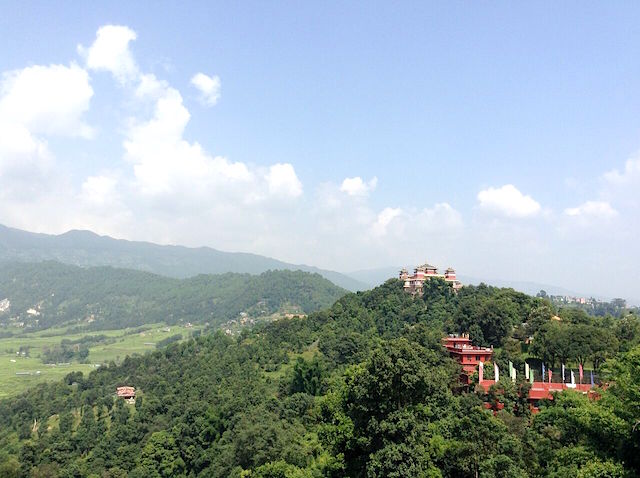
For 10 days each September, Kopan Monastery in Kathmandu, Nepal welcomes a stream of spiritual seekers from all over the planet to learn about the dharma and experience for themselves the compassion, patience, and wisdom of Tibetan Buddhism.
I’d just quit my job as a teacher in the United Kingdom. Surfing on this wave of liberation, I decided to do what I’d only ever dreamed of: I packed my bag and booked a one-way flight to Nepal. I wanted to discover the far side of the world and to explore the inner reaches of the spirit.
On 4th September, I arrived in the Himalayan foothills and entered the tranquility of Kopan’s walls. For 10 days, I immersed myself in an outer world of temple bells, Buddhas, Om Mani Padme Hums, and monks swathed in robes of burgundy and gold.
I dove into the depths of an inner world of silence, inter-being, and the infinite unknown. It was a time of deep contemplation, limitless patience, and unimaginable self-discovery. Everyone there entered into the stream of compassion, wisdom, and “the way.”
The retreat introduced ancient wisdom to a modern audience. Ten days felt like a whole life cycle.
These are the lessons I learned, lessons I’m still learning to apply to my day-to-day life six months later:
1. Dharma is a pair of jeans to wear in any walk of life.
The word “dharma” has many meanings: the truth, phenomena, the teachings of the Buddha, and “that which protects us from suffering.” Dharma is often referred to as “The Way.” This ancient way leads us from a life of suffering, pain, and anger to a life of compassion, serenity, and wisdom. However, we don’t have to travel to the other side of the world to discover this way. Dharma is a way of inner understanding. We don’t have to shave our heads and renounce the world to discover it. It is open to all of us, wherever we are, whatever our walk of life.
2. We are the artists of our world.
Our teacher for the retreat was a Swedish nun, named Ani Karin. She taught us about karma, suffering, impermanence, consciousness, and the Lamrim, the graduated path to enlightenment. One of her first lessons was that we are the artists of our life and the creators of our own world. We cannot control the world, but we can control our minds. Mind is the maker. Our minds often run wild like an untamed horse.
When we allow this emotional mind to take over, our action, speech, and thoughts become uncontrolled. In moments of anger, envy, greed, or pride, our ability to see things as they are is reduced and the results of this are rarely positive. However, what if we could tame the horse? This, Ani Karin taught, is what the practice of meditation is all about.
3. Meditation is all about getting to know our minds.
The Tibetan word for meditation is gom. It means familiarisation. We were taught to think of meditation as the art-science of familiarising ourselves with our thoughts. To master our minds, we need to understand our thoughts. By sitting with our thoughts for extended periods of time, we can get to know how we think, why we think in this way, and what the results of these patterns of thinking are. When the mind is tamed, we achieve a state of calm awareness to observe how mind, consciousness, and reality are interlinked and to overcome negative thinking. “Just as clouds are not in the nature of the sky,” Ani Karin says, “negative thoughts are not in the nature of the human mind.”
4. We are all Buddhas.
Buddha means “awakened one.” However, Buddhists don’t actually worship the Buddha. In spite of the golden statues, the incense, the arcane rituals, and prostration, Buddhists don’t believe that the Buddha is a god. They understand that he was just an ordinary human being who perfected himself and “woke up.” When Buddhists bow to the Buddha, they are really bowing to themselves as coming Buddhas. They are humbling themselves before a human being who mastered his own heart and mind. They are acknowledging the “Buddha nature” that exists inside all of us.
5. We should meditate on death.
Buddhists think that we in the West have an unhealthy relationship with death. We are scared by its finality and terrified by the finite nature of our lives. So we live to the max. We exhaust ourselves by doing the most we can in the limited time we have. We live according to the creed of YOLO.
Buddhists don’t fear death. In fact, they meditate on death. They contemplate the certainty of death as often as they can. They believe that when we truly realise just how fragile life is it changes our perspective on how to make the most of each moment. A nun called Wangmo (powerful woman) taught us how to meditate on death. Afterward, there was no fear. I felt grateful. I was fully aware of how fortunate I am simply to be alive right here, right now. The Dalai Lama meditates on death every morning. He’s always in a cheerful mood.
6. Every living being used to be our mum.
Buddhists believe that the universe has no beginning. Samsara has always existed. Time is infinite. This means that in the stream of past lives, every single living being has at one point been our mother. Harming any creature, we were taught, is therefore the same as harming our mother. All week, there wasn’t one complaint about the vegetarian food. As we sat in the temple meditating, nobody swatted away the flies or mosquitoes. Every hour somebody stood up and walked outside, cupping a spider in their hands to return to the safety of a flowerbed.
7. We are how we eat.
Everything is interdependent. Without other people, where would we be? If we bear this in mind before we eat a meal, each mouthful becomes a delicious burst of gratitude. Before each meal, I’d stop, close my eyes, and reflect on what I should be thankful for: the cooks who prepared the meal; the farmers who grew and harvested the food; the drivers who delivered the food; the factory that produced the cutlery, the bowls, the plates; the carpenters who made the table and the bench; the builders who built the canteen; the thousands of people in my life whose advice, kindness, and criticism led me to a monastery in Nepal, whether they realise it or not; the nuns who were teaching us about gratitude. If we practice gratitude, we can discover the joy of eating mindfully. Admittedly, it might add a few minutes to meal times though.
8. A tree isn’t a tree.
“What is a tree?” a monk asked us one afternoon. There was silence. It seemed a self-evident question. It wasn’t. “If we closely analyse what a tree is,” he told us, “we find that it isn’t really there. We can find the leaves, the flowers, the branches, the trunk, the bark, the sap, and the roots. A tree wouldn’t be a tree without any of these things. We can also find the soil, the water, the clouds, the sun, and the air, without which a tree couldn’t survive. But…where is the tree?’” Again, there was silence. The riddles continued. “And what is a tree if no one is there to see it? Until we think of it as a tree, a tree is empty of form.” There was silence again. All of us knew in that moment that a walk in the woods would never be the same again.
9. When you get to the top of a mountain, keep climbing.
This is a famous koan or Zen riddle. Koans are supposed to trick us into realizing the limits of our rational minds. Koans employ paradox to achieve satori, an insight into one’s true nature and the nature of reality. I never understood this riddle until I spent time with a guy called Sean in the monastery. He worked on Mount Everest—known to the Nepalese as Sagarmāthā or “Mother of the Universe”—guiding expeditions to the summit. Sean has summited Everest several times. One afternoon as we were all chatting on a rooftop, he ruminated pensively, “When you’ve climbed the highest mountain in the world, what’s next?” Spending his time deep in meditation, perhaps Sean didn’t realise it, but he was still climbing.
10. It’s possible to fall in love in a monastery.
When we stop searching for what we want, what we’ve been waiting for can reveal itself. When we connect to deeper meaning, cultivate patience and compassion for ourselves and others, attune to the silence between our thoughts, and really listen to people, it’s possible to get to spend what feels like a lifetime getting to know someone in only 10 days.
And after these days, nothing will ever be the same again.
Author: James Pinnock
Image: Author’s Own
Editor: Sara Kärpänen
Copy Editor: Travis May








Read 1 comment and reply